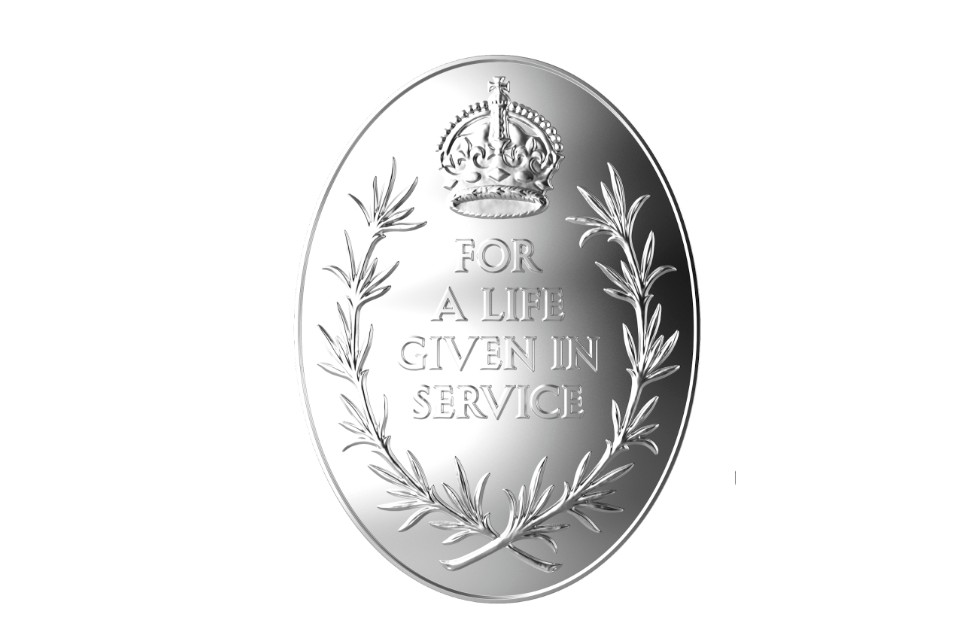The Elizabeth Emblem - application guidance and eligibility
On 9 March 2024, the Government announced the introduction of The Elizabeth Emblem. This commemorative emblem is awarded as a mark of recognition to the next of kin of those who lost their lives in the course of undertaking eligible public service.
Documents
Details

On 9 March 2024, the Government announced the introduction of a commemorative emblem as a mark of recognition for those who lost their lives in the course of undertaking eligible public service.
The design incorporates a rosemary wreath, a traditional symbol of remembrance, surrounding the Tudor Crown. It will be inscribed ‘For A Life Given In Service’ and will have the name of the person to be commemorated inscribed on the reverse of the emblem.
The Emblem will include a pin to allow the award to be worn by the next of kin of the deceased. The grant of The Elizabeth Emblem will be accompanied by a miniature, and either may be worn by the recipient at that person’s discretion.
The Emblem will carry no rights to the use of post-nominal letters.
Eligibility Criteria for The Elizabeth Emblem
1. A person will be eligible to be commemorated by the granting of The Elizabeth Emblem if they died in the course of undertaking eligible public service, such public service to include:
- Employment in a role by, on behalf of, or formally funded by, an eligible body. An eligible body will be defined as the UK Government, the Scottish Government, the Welsh Government, the Northern Ireland Executive, local government, a Crown Dependency or a British Overseas Territory;
- Working - either in a paid or voluntary capacity - at the behest of an eligible body. This will include any person who has a formal contract or agreement to work for the eligible body or who has been ordered to provide a service; and
- Working as part of emergency services personnel in a paid or voluntary capacity, dealing with emergencies either directly or indirectly as part of their conditions of service. Emergency services personnel will include: control room staff and civilians working for the police services, ambulance services and fire and rescue services of the United Kingdom of Great Britain and Northern Ireland or a Crown Dependency or British Overseas Territory, as well as persons working for mountain, cave and water rescue services, weather and natural disaster response services, and coastguard services.
2. The death of the person to be commemorated shall have been directly attributable to the public service in question. This will include:
- Where the death occurred as a direct result of action being taken in the course of public service;
- Where the person to be commemorated has been targeted as a result of their public service role or action, whether on or off duty;
- Where the person to be commemorated has died as a result of an operational call out, whether routine or emergency, if responding to the call resulted in their death; and,
- Where the person to be commemorated died as a result of acting to assist in an emergency situation for which they were trained, even if formally not on duty at the time.
3. Those undertaking eligible public service may be drawn from any nationality. (If the deceased was not a British citizen, the granting of this award will be subject to the agreement of the state for which the deceased held citizenship.)
4. The death must have occurred on or after 1st January 1948 or have taken place in Palestine between 27 September 1945 and 31 December 1947.
5. Eligible persons who subsequently died as a result of illness or injury attributed directly to qualifying service may also be commemorated by The Elizabeth Emblem.
6. A person will not be eligible to be commemorated by The Elizabeth Emblem if:
- At the time of their death or during their service with the relevant organisation they were engaging in a criminal act or acting in such a way as to place themselves or others at additional risk to their life; or
- They are eligible to be commemorated by the granting of The Elizabeth Cross.
7. The person eligible to receive The Elizabeth Emblem shall be the person recorded to be the next of kin or if no such record exists, the first person from the following list who is still alive. This order of precedence is based on the rules of intestacy:
- Surviving spouse
- Eldest child, followed by other children in descending order of age
- Eldest grandchild/great grandchild
- Parents, including adoptive parents
- Siblings who share both parents (referred to as “of the whole blood”)
- Children of siblings who share both parents (“of the whole blood”)
- Siblings who share one parent (referred to as “of the half blood”)
- Children of siblings who share one parent (“of the whole blood”)
- Grandparents
- Aunts or uncles
- Children of aunts or uncles
- Half-aunts or uncles
- Children of half-aunts or uncles
8. The next of kin will receive The Elizabeth Emblem and a Memorial Scroll inscribed with the name of the person to be commemorated by the granting of The Elizabeth Emblem. The Elizabeth Emblem will be accompanied by a miniature. Both The Elizabeth Emblem and the miniature may be worn by the recipient at that person’s discretion. The Emblem is not a medal and should not be worn directly with other medals.
9. For historic claims when the deceased’s next of kin is also deceased, their legal successor may apply.
10. An additional person who is not recorded as the next of kin may be eligible for an additional Memorial Scroll only (not The Elizabeth Emblem itself), if they are:
- A parent of the deceased person; or
- The spouse or partner of the deceased person or someone who had a substantive relationship with them.
Application process
Applications can be submitted by completing The Elizabeth Emblem application form.
As outlined on the form, the following information must be provided:
1. Details of the Applicant (the person who is next of kin)
2. Details of the Deceased (the person who died)
3. Circumstances of death. This should include details about how the deceased person died.
4. Supporting documentation which may include:
- Proof of the deceased person’s employment or service with an organisation in scope of recognition.
- A copy of the deceased person’s death certificate.
- Where available, a copy of the relevant page of the deceased person’s Last Will and Testament where this records the next of kin. Alternatively, other documentation which formally records the next of kin can be provided. This may include a marriage certificate, an adoption record, a death in service form or anything else which identifies the next of kin.
- Where relevant, a copy of a coroner’s or other official’s report where an inquest or equivalent investigation was held.
- Any relevant investigation or police reports.
- Any relevant media articles reporting about the death, or other documents that help prove eligibility for The Elizabeth Emblem.
It is essential to wait until all legal proceedings (including inquests) are complete before submitting an application.
Applications for deaths occurring after 9 March 2024 should ideally be made within 12 months of the death - subject to any ongoing legal proceedings. When an application is submitted more than a year after a death has occurred, the Secretariat will ask about the circumstances.
After you submit the application for The Elizabeth Emblem
The Honours and Appointments Secretariat will arrange for your application to be verified to ensure that it meets the eligibility criteria. It is important to note that it is the responsibility of the applicant to provide the required evidence in order for the application to be considered by the George Cross Committee. If the evidence does not provide the necessary information, the Secretariat will be in touch to discuss next steps.
The George Cross Committee will assess applications before a recommendation is made to the Prime Minister and HM The King. Awards are announced in the London Gazette and on gov.uk.
It may take several months for a case to be considered and an award approved, presented and published. If there are timing considerations relevant to either assessment of the award or its publication, please let the Secretariat know on application.
George Cross Committee Members
- Sir Chris Wormald KCB (Chair)
- Private Secretary to His Majesty The King
- Principal Private Secretary to the Prime Minister
- Permanent Secretary of the Ministry of Defence
- Dame Mary Marsh (independent member)
- Lord Evans (independent member)
Further information about The Elizabeth Emblem can be obtained from the Honours and Appointments Secretariat in the Cabinet Office. Please email elizabethemblem@cabinetoffice.gov.uk
How the Cabinet Office collects and uses personal information
Details are available on the privacy information relating to honours nominations
The award of The Elizabeth Emblem does not reflect an acceptance on the part of either HM Government or any employer of any legal liability in respect of the death in respect of which the award is made.
Applications will not be considered until the conclusion of any relevant legal processes.
Last updated 12 March 2024 + show all updates
-
Added the document: The Elizabeth Emblem - Statement made on 11 March 2024 The Elizabeth Emblem - Command Paper
-
First published.
Update history
2024-11-09 00:01
Added the document: List of recipients of the Elizabeth Emblem – 9th November 2024
2024-03-12 10:46
Added the document: The Elizabeth Emblem – Statement made on 11 March 2024The Elizabeth Emblem – Command Paper
2024-03-09 00:01
First published.
